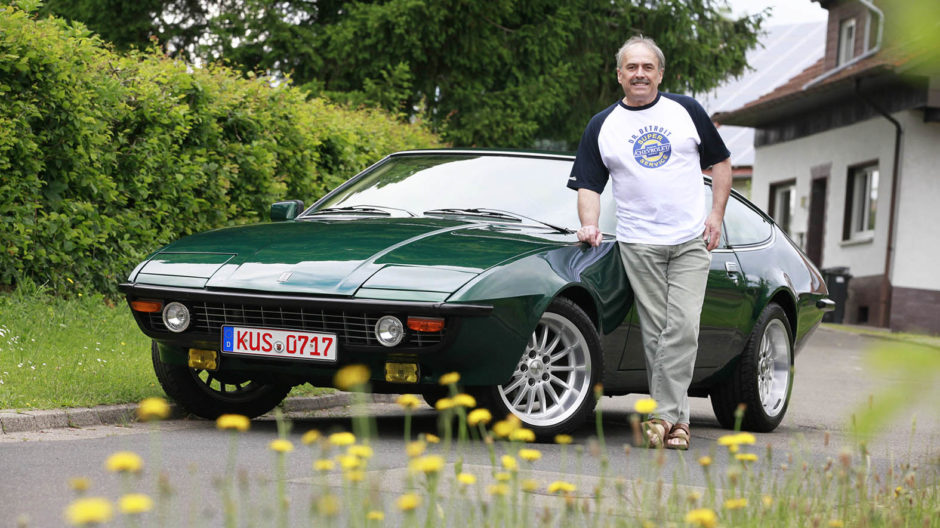- Udo Schmitt and his Bitter CD. “It is the most beautiful car I’d ever seen,” he recalls.
- Schmitt bought the car being a big rusty pile of junk. Then he began working on the dead car in his spare time – brushing, sanding, soldering, tightening screws, and painting. He never thought to count the hours he devoted to working on his dream. The result proves: It was well worth the effort.
- Apart from a tractor: First, there is the Bitter CD, once belonged to a certain Hermann-Harmut Weyer, the ‘Consul of Yorck’.

So love at first sight does exist. Udo Schmitt knew it right away when he saw an Opel Bitter CD for the first time. This was nearly 40 years ago. He had just started work as an electrician at Opel in Kaiserslautern when a promo model of the legendary sports car rolled through the gates of the plant. “It was the most beautiful car I’d ever seen,” recalls Schmitt, now 60 and residing in Ulmet. “I had to go through a pile of car magazines to find out that it was a Bitter CD. No such thing as the Internet back then!”

Udo Schmitt is ‘Dr. Detroit’, an American created the nickname. Schmitt’s DIY repair shop now bears its own ‘Dr. Detroit’ logo, which is also printed on his T-shirts.
Schmitt does not ‘drive’ a car. He’s cruising
He could not get over the memory of this automotive beauty, created for Opel by acclaimed designer Erich Bitter. It still had a hold on Schmitt when he became a passionate tinkerer and developed a taste in cars you wouldn’t normally expect from a boy from the rural Palatinate. Even today, he would never say that he simply ‘drives’ a car – what Schmitt does is ‘cruising.’ And as it so happens, GM-brand Chevrolet road cruisers are especially well suited to this task.
energy crisis makes the 200-hp Camaro affordable
He was in luck: The energy crisis of the 1970s made second-hand, American-made gas guzzlers affordable for the less affluent. “When the gas prices began skyrocketing, people just wanted to get rid of their big American cars that often guzzled 20 liters per 100 kilometers.” That is how Schmitt, by now a maintenance technician at the Kaiserslautern plant railway, was able to afford a 1967 200-hp Camaro at such a young age. But the Bitter, which was produced only in very limited numbers, still remained out of reach.
“The seller poured me a vodka orange to seal the deal. She said she was a dancer at the Lido in Paris, which I think might have been a bit of an exaggeration.”
In 1980, he received an offer for his Chevy that he could not refuse. But he soon found a replacement: a 1971 Chevelle Super Sport 396, which he bought in Frankenthal. It was the epitome of a ‘muscle car,’ complete with imposing air scoops on the hood. In the U.S., enthusiasts now pay up to $300,000 for these powerhouses. Back then, Schmitt got it for less than a hundredth of that. “The seller poured me a vodka orange to seal the deal. She said she was a dancer at the Lido in Paris, which I think might have been a bit of an exaggeration.”
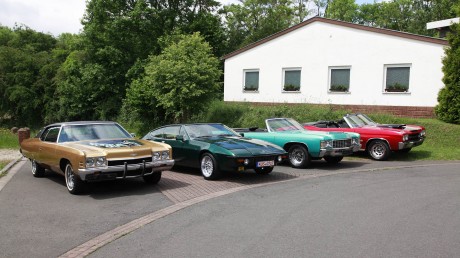
Schmitt’s collection, three Chevy cars, one Opel: Impala Coupé, Bitter CD, Chevy Caprice and Chevelle Super Sport 396 (f.l.).
disco in St. Wedel – amazing times
But it was only the beginning. In the same year, he came across an offer for a 1972 Impala Coupé. Measuring over 5.5 meters in length, the car was Chevrolet’s flagship in the ‘full size’ segment. And it cost Schmitt just 2,000 Deutschmarks! At first, he was only interested in its V8 engine, but he enjoyed driving it home from Friedberg in Hesse so much that he decided to keep the whole car. “I cruised in it for years with my friends to the disco in St. Wedel. Those were amazing times. Just for the sake of those memories, I would never let go of the Impala.”
‘Chrome on Fire’ magazine brings him on track
In 1990, Schmitt stumbled upon a Chevrolet Caprice in a magazine suggestively entitled ‘Chrome on Fire.’ Again, he could not resist, and this exclusive GM cruiser made its way to his garage from the Odenwald region. The arguably most eccentric vehicle fleet of the Western Palatinate now appeared to be complete. But there was still one more to come – Schmitt’s yearning for the Opel Bitter had not yet been fulfilled.
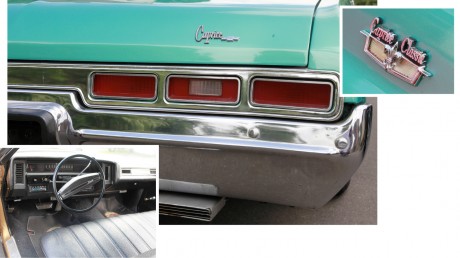
Old school inside and outside: The Caprice is in Schmitt’s garage since 1990.
a stethoscope to listen to the engine noise
In the meantime, American soldiers stationed in the Palatinate region had heard rumors of a Chevy die-hard living in the back country of Kusel who knew everything about repairing GM cruisers. One of them brought over his Camaro for Schmitt to check out. When Schmitt whipped out a stethoscope to listen to the engine noise, the American burst into laughter and gave this ‘crazee German’ a nickname that would stick – ‘Dr. Detroit.’ It spread like wildfire. Schmitt’s DIY repair shop now bears its own ‘Dr. Detroit’ logo, which is also printed on his T-shirts.
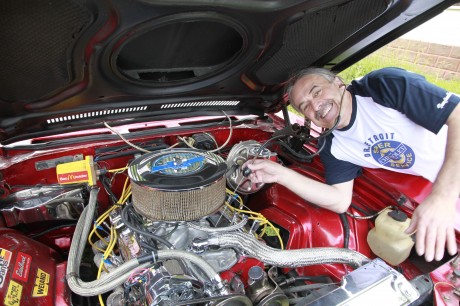
Man, stethoscope, car: Dr. Detroit checks the engine noise.
When Schmitt whipped out a stethoscope to listen to the engine noise, the American burst into laughter and gave this ‘crazee German’ a nickname that would stick – ‘Dr. Detroit.’
“I swear, I was trembling at the knees”
The new millennium had already begun when an Opel dealer from Elkersweiler in the Palatinate approached him. “I’ve got this totally run-down car in the barn,” he said. “A Bitter CD.” Schmitt’s heart leaped into his throat. The dealer continued: “I actually wanted to fix it up myself, but I’m just not getting around to it.” Without a moment’s hesitation, Schmitt asked, “Can I see it?” – “I swear, when we went to the barn together, I was trembling at the knees,” recalls the 60-year-old. And there it was: his great love. Although most other people would have simply seen a big rusty pile of junk.
his friends snickered and his mother shook her head
Overjoyed, Schmitt took what was left of the Bitter to his workshop, while his friends snickered and his mother shook her head. He couldn’t care less and began working on the dead car in his spare time – brushing, sanding, soldering, tightening screws, and painting. He never thought to count the hours he devoted to working on his dream. Then one day, he was finished. Among others, Schmitt contacted the ‘Bitter Club International’ to get access to spare parts and information. The club was able to trace the original owner of any Bitter CD through its serial number.
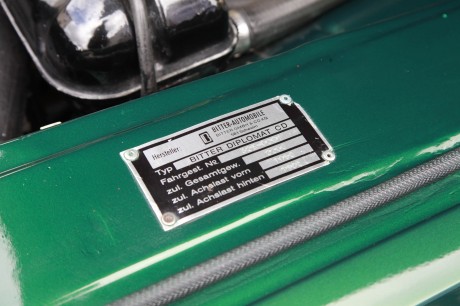
Schmitt was able to trace the original owner of his Bitter CD through the serial number: The car belonged to a certain Hans-Hermann Weyer, the ‘Consul of Yorck’.
the ‘Handsome Consul’ resides a few doors down from Pelé
As it turned out, the Bitter that Dr. Detroit had been restoring to its original dark green gleam had once belonged to a certain Hans-Hermann Weyer, the ‘Consul of Yorck.’ Older readers will perhaps still remember the ‘Handsome Consul,’ a shady trader in titles, companion to beautiful women, and all-round attention seeker who was a mainstay of Germany’s tabloid scene for many years. Today, his life seems to be a little more discreet. Apparently, the ageless charmer – who refers to himself as the ‘male Greta Garbo’ – resides mostly in Rio de Janeiro a few doors down from football legend Pelé.
No title of nobility but: “much happiness with the vehicle”
Schmitt got a hold of the handsome consul’s e-mail address through an Opel connection, wrote him a brief message, and sent him a photo of the restored classic. Lo and behold, the consul was delighted, and in return sent back an old newspaper article from his youth in which he was posing in front the racer, and wished the new owner “much happiness with the vehicle.” He probably also would have sold Schmitt a title of nobility if he’d had one handy.
Not long ago, the rear view mirror of the Bitter CD fell apart, for no other reason than plain old age. Since the prices for original spare parts have reached breathtaking heights among enthusiasts, Schmitt installed a Corsa rear view mirror – “it works,” he says matter-of-factly.
Schmitt is more content than ever with his treasure on wheels, even if he still has to spend a great deal of time working on it. “It’s not at all easy to keep a classic like that in good condition,” says Dr. Detroit. “As Neil Young knew full well, ‘Rust never sleeps.’” Not long ago, the rear view mirror of the Bitter CD fell apart, for no other reason than plain old age. Since the prices for original spare parts have reached breathtaking heights among enthusiasts, Schmitt installed a Corsa rear view mirror – “it works,” he says matter-of-factly.
The time of the Omega will come
Dr. Detroit, who retired from Opel two years ago, also continues to take very good care of his Chevrolets. His everyday car is an Opel Omega, purchased in 1999. “Car lovers don’t appreciate it yet, but they will one day.” He only takes out the classic cars once in a while, “otherwise I wouldn’t be able to really enjoy it.” After all, it’s always more fun to ‘cruise’ than it is to drive.
Bella Italia
When it was introduced to the public at the IAA in 1974, many shook their heads in disbelief: “That’s supposed to be an Opel? It looks like an Italian car!” This is precisely the reaction that Erich Bitter wanted to elicit. His aim had been to construct a German sports car that could stand up to those from the other side of the Alps, both in terms of style and elegance.
It was to be assembled at the Stuttgart-based chassis manufacturer Baur under the Opel label, while the Rüsselsheim plant was to contribute the drive train taken from the Opel Diplomat. A 5.4-liter V8 engine from Chevrolet throbbed under the hood.
The media went into a frenzy. Over the course of the IAA alone, 200 orders were received for the Bitter. But then came the energy crisis. Gas prices went sky-high, and the demand for gas-guzzling luxury sports cars collapsed overnight.
Opel, making a virtue out of a necessity, positioned the Bitter CD as a prestige model, offered predominantly to VIP customers. This is how Consul Weyer, a few 1974 World Cup heroes such as Paul Breitner and Bernd Hölzenbein, and easy listening icon Heino became Bitter owners.
A total of 395 of the cars had been produced by 1979. According to the ‘Bitter Club International,’ more than half of them are still on the road today – thanks to enthusiasts and collectors like Udo Schmitt.
Incidentally, Schmitt once had the remains of Heino’s Bitter in his possession. “But then there came a time when I needed to focus on other things. Still, I was extremely reluctant to let it go.”
